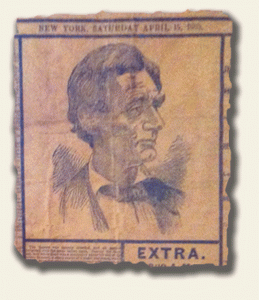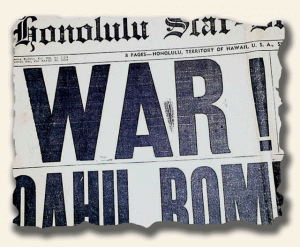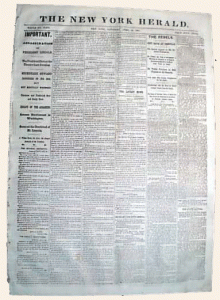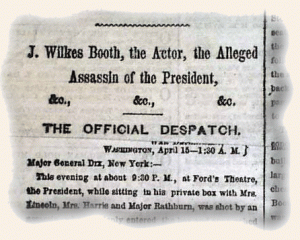April 15, 1865 New York Herald reprints… revisited…
November 1, 2010 by GuyHeilenman · 10 Comments
 A previous post by guest contributor Rick Brown detailed how one can identify whether or not their April 15, 1865 New York Herald is authentic. One of the most notable differences between an authentic issue (which is quite rare) and one of the reprints (which are rather common) is that the common reprint has an image of President Lincoln on the front page, whereas, the original does not. We recently came across a photo of the Lincoln image (as shown to the right). If your issue has it… unfortunately, your’s is not an original.
A previous post by guest contributor Rick Brown detailed how one can identify whether or not their April 15, 1865 New York Herald is authentic. One of the most notable differences between an authentic issue (which is quite rare) and one of the reprints (which are rather common) is that the common reprint has an image of President Lincoln on the front page, whereas, the original does not. We recently came across a photo of the Lincoln image (as shown to the right). If your issue has it… unfortunately, your’s is not an original.
Your help would be appreciated…
June 14, 2010 by TimHughes · 10 Comments
 Rick Brown, not unknown in our little world of newspaper collecting, is embarking upon a project and seeks your help.
Rick Brown, not unknown in our little world of newspaper collecting, is embarking upon a project and seeks your help.
Rick published “Collectible Newspapers” for many years and created the Newspaper Collectors’ Society of America along with producing several projects which remain valuable to our hobby today, including the “List of Common Reprints” found on our website. His current project is producing a list of all known reprint editions of the New York Herald of April 15, 1865, perhaps the most commonly reprinted newspaper on the market. He has identified 35 different versions and is lacking a few including:
* Kitchel’s Liniment for 1890, 1892 through 1899, 1903 and 1904, 1906
through 1908. (The date for each can be found at the
top margin of page 2.)
* Smith’s Buchu Lythia Pills
He also wishes to produce a reprint of the front pages of each of the four
genuine editions of the newspaper for free online use. Should you have a genuine New York Herald, April 15, 1865 in your collection, or one of the reprint edition editions noted above, please be in touch with Rick directly for details on how to assist in his project: Curator@historybuff.com
19th century newspapers… revisited…
December 26, 2009 by GuyHeilenman · 1 Comment
Over the past three weeks Timothy Hughes has explored his thoughts concerning what he believes to be the top ten newspapers from each of the pre-18th, 18th, and 19 centuries (see below), the most recent being the latter. Some of his thoughts concerning the 1800’s historic newspapers were captured in the following video:
Collecting authentic rare and historic newspapers from the 1800’s can be exciting, rewarding and surprisingly affordable. Daily newspaper reports of America’s tumultuous 19th Century included first hand accounts of historic turning-points like….. the Louisiana Purchase…the Civil War…and Spanish-American conflict. As cries of “manifest destiny” signaled America’s unbridled expansion west, newspapers became a crucial link for a people suddenly united in a common quest that would set their young nation on a course of unprecedented and historic prosperity.
There are many sought after “holy grails” from the 19th century, including: o President Abraham Lincoln’s Assassination o Battle of Gettysburg and the Gettysburg Address o Battle of the Alamo o Deaths of Jessie James and Billy the Kid o Issue from Tombstone Arizona (Tombstone Epitaph) o Winslow Homer’s “Snap the Whip”
Of course, select accounts of the most historic & desired events of 19th century America are available for premium prices.
However, a wealth of fascinating original newspapers from the vast inventory of Timothy Hughes Rare & Early Newspapers are available for much less…often as little as $30 – $50. These include first-hand news from the War of 1812, Yankee & Confederate Civil War battle reports, slave ads from the South, the California Gold Rush with outlaw & Indian battle accounts, the Mormon migration to Utah and fascinating reports of when baseball was in its infancy.
The “Old West” and America’s westward expansion are represented in genuine newspapers from California, Utah, Nevada, Montana, and Arizona. You’ll also find affordable issues from the illustrated press which graphically documented every aspect of 19th century America in the pages of Harper’s Weekly, Frank Leslie’s Illustrated, Gleason’s, Ballou’s, and The London Illustrated News.
Whether your interest is in the War of 1812, westward expansion and the gold rush, the Civil War, and/or the Wild West, original newspapers provide an excellent view of history in context. History is never more fascinating than when when it’s read from the day it was first reported. If you love history… you deserve to have it in your hands. Rare newspapers make this possible. Please enjoy the hobby.
Top ten newspapers: 16th and 17th centuries…
Top ten newspapers: 18th century…
Top ten newspapers: 19th century…
Terrific “association” item in American history…
October 22, 2009 by TimHughes · 2 Comments
One of the joys in collecting early newspapers is discovering the little gem found buried in an issue which was innocuous at the time but which has since transcended to much greater importance in American history. The small advertisement shown, which appears on page 3 of the April 13 issue of the “Daily Morning Chronicle” of Washington, D.C., is one.
 Certainly Abraham Lincoln, and any other Washington, D.C. resident who read this ad, would not have given it a second thought, being a simple notice of the latest show on the stage of a local theater. But as history would tell us Abraham Lincoln attended this very performance of “The American Cousin” at Ford’s Theatre, starring Laura Keene, and would be assassinated there the evening of the 14th.
Certainly Abraham Lincoln, and any other Washington, D.C. resident who read this ad, would not have given it a second thought, being a simple notice of the latest show on the stage of a local theater. But as history would tell us Abraham Lincoln attended this very performance of “The American Cousin” at Ford’s Theatre, starring Laura Keene, and would be assassinated there the evening of the 14th.
It’s fascinating to think the original owner of this newspaper may well have read that advertisement, and may actually have attended that performance only to become witness to one of the more dramatic & notable events of American history. This newspaper is truly a piece of Americana which could only be found in a Washington, D.C. newspaper. Certainly this ad would not have appeared in the other–more common–major city publications.
Feel free to respond and share with other readers any similar gems which you have discovered, & which would figure more prominently in history after their publication date. We hope you enjoyed this one!
My Collecting Story… Richard Sloan…
May 28, 2009 by GuyHeilenman · 1 Comment
 I’ve been interested in the Lincoln assassination ever since I was thirteen years old. The 19th century images really grabbed me, and continue to give me a sense of what took place. As a New Yorker, my interest expanded to Lincoln’s N.Y.C. funeral, Lincoln’s prior trips to NY, Mrs. Lincoln’s NYC shopping sprees, and John Wilkes Booth’s activities in the city. In the course of all of this, I also became interested in 19th century NY photographers, theaters, hotels, and department stores. It has become obvious to me that period photographs convey and impart just so much. The old newspapers turned out to be the missing ingredient. There is nothing like holding an old NYC newspaper in my hand (or a weekly like Harper’s, Leslie’s, Gleason’s, etc;). Turning old pages that someone had turned in 1865 doesn’t just provide research information; it takes me back in time and shows me what life was like. It’s a wonderful experience to re-capture the sense of immediacy and news-gathering that someone had experienced back then when he or she turned those very same pages — whether it’s reading the details of Lincoln’s 1861 arrival in the city, reading the details of such events as his assassination, his funeral, finding out what parades took place in town the previous day, or what shows are currently playing in town. Old newspapers are time machines!
I’ve been interested in the Lincoln assassination ever since I was thirteen years old. The 19th century images really grabbed me, and continue to give me a sense of what took place. As a New Yorker, my interest expanded to Lincoln’s N.Y.C. funeral, Lincoln’s prior trips to NY, Mrs. Lincoln’s NYC shopping sprees, and John Wilkes Booth’s activities in the city. In the course of all of this, I also became interested in 19th century NY photographers, theaters, hotels, and department stores. It has become obvious to me that period photographs convey and impart just so much. The old newspapers turned out to be the missing ingredient. There is nothing like holding an old NYC newspaper in my hand (or a weekly like Harper’s, Leslie’s, Gleason’s, etc;). Turning old pages that someone had turned in 1865 doesn’t just provide research information; it takes me back in time and shows me what life was like. It’s a wonderful experience to re-capture the sense of immediacy and news-gathering that someone had experienced back then when he or she turned those very same pages — whether it’s reading the details of Lincoln’s 1861 arrival in the city, reading the details of such events as his assassination, his funeral, finding out what parades took place in town the previous day, or what shows are currently playing in town. Old newspapers are time machines!
– – – – – – – – – – – – – – – – – – – – – – – – – – – – – – – – – – – – – – – – – –
Thanks for sharing your story Richard. If you would like to share your story of how you became interested in collecting rare and/or historic newspapers, e-mail it to guy@rarenewspapers.com and place “My Story” in the subject field. Although not necessary, feel free to include an image. Please do not include your e-mail address or a personal website as part of the text of your story. We will post collector stories every few weeks and will send you a notice when your story appears. Thank you for your contribution to the community.
Genuine or reprint?
March 26, 2009 by TimHughes · 30 Comments
A great fear of any novice collector is knowing whether an item purchased is genuine or not. It’s a valid concern, as the other collectibles have been infested by reproduction,s reprints, or deceivingly fake material from furniture to coins to baseball collectibles.
The world of rare newspapers is not immune but it is not a serious problem either. With a few helpful hints almost every collector can avoid the pitfalls of having non-genuine newspapers end up in their collection.
Fake material of any collectible seems to become an problem when popularity and values grow. Since rare newspaper collecting remains a relatively unknown hobby with relatively low prices there is little incentive to create fake editions. And the requirements to recreate a 200 year old newspaper to have it look like a genuine edition can be complex and expensive.
With but one exception, I am not aware of any reprinted newspapers which were created to deceive. Virtually all facsimile issues on the market were created as souvenirs of historic events (Honolulu issues on Pearl Harbor can still be purchased at the memorial), on anniversaries of the first issue printed (many volume one, number one issues are reprints), as curious give-aways or “premiums” (major events such as the Boston Massacre, Declaration of Independence, etc. were reprinted), or as teaching tools in an educational environment (Harper’s Weekly issues from the Civil War were reprinted on their 100th anniversary: look for “a reissue of” above the “H” in “Harper’s Weekly” on page 1).
The lone exception is a collection of the “Pennsylvania Gazette” from the 1730’s – 1787 with issues turning up in small auction halls throughout the East some 20 years ago. The issues were aged to look 200 years old and the paper was very close to genuine newsprint from the era. Beware of this title if it contains a “Tontine Coffee House” inked stamp on the front page & if it looks a bit washed out.
The number of reprint newspapers on the market is exceedingly small so collectors have little to worry about. But keep these points in mind:
1) The most common reprint newspapers are on the Library of Congress check-list. Go here to keep the list handy. It also includes helpful tips on how to tell if genuine or a reprint.
2) Be aware of what 200 year old and 100 year old newsprint should look like. Almost all reprints were done on paper which is not reflective of the era.
3) Be suspicious of exceedingly historic newspaper turning up in illogical places. The likelihood of a genuine Declaration of Independence report being in flea market or amongst of group of papers from a non-collecting family is very remote. In other words if the find seems too good to be true, it likely is.
4) Be careful with volume one, number one newspapers. Such first editions were commonly reprinted by the publisher on the 50th or 100th anniversary.
5) Above all, buy from reputable dealers whose expertise, experience and reputation stand behind all they sell.
 The “Honolulu Star-Bulletin” of Dec. 7, 1941 mentioned above is not on the Library of Congress check-list, however it’s easy to spot a reprint. The genuine issue has an ink smear between the “A” and “R” in the huge word “WAR!” on the front page (see photo). They cleaned it up on the reprint so it won’t be present.
The “Honolulu Star-Bulletin” of Dec. 7, 1941 mentioned above is not on the Library of Congress check-list, however it’s easy to spot a reprint. The genuine issue has an ink smear between the “A” and “R” in the huge word “WAR!” on the front page (see photo). They cleaned it up on the reprint so it won’t be present.
And a news flash–I just learned that the “Dallas Morning News” issue of Nov. 23, 1963 reporting Kennedy’s assassination has been reprinted. Look for the word “Reprint” in the dateline just after the four stars. Do note those we have on our website & have sold for over 20 years are all genuine!
Common sense can be the best guide. The requirements to reprint an 8 page Civil War newspaper with a minor battle report could cost hundreds of dollars while the genuine issue might sell for $20, so chances are good such finds are genuine. For this reason our hobby is a fascinating one not prone to the pitfalls of other collectibles.
Our community of collectors is quite small which has worked in our favor. All of us are in an enviable position of being able to assemble great collections of historic material before the world at large “discovers” our hobby and changes the environment in years to come.
Enjoy!
April 15, 1865 New York Herald Reprints
September 30, 2008 by GuyHeilenman · 97 Comments
Quick note: If you have an April 15, 1865 New York Herald and it has either an illustration of Lincoln on the front page, or, if it is the “Extra 8:10 AM” edition, it is a reprint. Other reprints exist, but these are the most common. Additional information can be found below and via the Library of Congress’ website.
From our guest contributor, Rick Brown:
I have been collecting Lincoln assassination ephemera for 43 years now. Since I am listed in several directories, I average 2 to 3 telephone calls a month from people wanting to know the value of their old newspapers. In the past 43 years I have been offered the April 15, 1865 New York Herald perhaps as many as 10,000 times and only once was it an original. I’ve heard many a story like “It can’t be a reprint because my great grandfather fought in the Civil War and bought it in New York and brought it back home.” One of the strangest responses I received when I informed the owner their specimen was a reprint was: “Producing a reprint is against the law. Therefore it HAS to be an original!”
To add to the confusion, the first reprint was produced in 1871 and the last about 1908. (This does not include the reprints printed on parchment – those are still being produced today.) Thus, the reprints DO look old because they are old.
In 1995 I did extensive research into newspaper reprints including the April 15, 1865 New York Herald. At that time I documented 32 different versions. The only Herald reprint produced on rag linen was a single sheet printed on both sides. The back page has a large ad for Grain-O-Coffee (who later became the originators of JELLO) and was produced in 1871.
Due to the nation’s centennial in 1876, interest in major events in American history was high. Publishers produced literally a hundred different newspaper reprints of various titles.
Starting in 1890, Kitchel’s Liniment, a patent medicine company, produced an annual version of the April 15, 1865 New York Herald. The front and back page remained the same. Pages 2 and 3 were testimonials for Kitchel’s Liniment. At the top of page 2, centered in the margin, was the phrase “Use Kitchel’s Liniment (1890) and Forever.” Each subsequent annual reprint changed the year in the phrase. The last Kitchel’s Liniment reprint version I have found is 1908. Another patent medicine company that produced New York Herald reprints was MA-LE-NA liver pills. They, too, produced annual reprint versions but with no date indicated like with Kitchel‘s Liniment.
The assassination of President Garfield and McKinley also saw reprints of the April 15, 1865 New York Herald produced. Ford’s Theater and various museum gift shops also sold these reprints and still do today.
While very few actually indicated on the paper itself that is was a reprint, it is important to note that NONE of these reprints were meant to deceive. In the case of the patent medicines, people were hired to give the reprints away at county fairs or other places where a large quantity of people would be gathering. The reprints were a marketing device. It was reasoned that having the Lincoln assassination news on the front and back page, people would not throw them away like they would if it were just a flyer advertising their product.
In the 1930s, however, the height of the American depression, there were a few scam artists who went door to door selling a “valuable relic of American history” – An old April 15, 1865 New York Herald reprint they had obtained in quantity. Unknowing people would take what little cash money they had and purchase it for $1 or so (big money in those days.) They were hoping to sell it for much more. Meanwhile, the scam artist had moved on to another city.
Of the 32 versions I have documented, only one was printed on rag linen; the Grain-O-Coffee one. Four of the versions were single sheet and printed on both sides. All four of these have the date April 15, 1865 on the front page and April 14, 1865 on the back page. Three were printed on parchment paper and the other one on wood pulp paper. The rest of the reprints were 4-page editions. Of the 32 reprint versions, all but 6 of them have printed on the front page in the forth column from the left and about six inches down the phrase EXTRA 8:10 AM is printed. There were NO original 8:10 AM EXTRA editions produced. Originals have eight pages and were printed on rag linen.
One of my continual searches on Ebay is “April 15, 1865 New York Herald.” Currently, on average, there are 3 to 4 of these placed on Ebay on a weekly basis. Very few correctly state that they are offering a reprint. Most claim to be originals. From time to time I will send an email to the seller pointing out that their specimen is actually a reprint and referring them to my site for further information. – http://www.historybuff.com/library/refhotlist.html. Of each ten sellers I send the email to, on average, four thank me for pointing it out to them but seldom edit their listing to point out that it is a reprint; four do not respond at all; and, shamefully, two reply back with something like “You know it is a reprint, and I know it is a reprint, but THEY don’t know it’s a reprint.” In the past 12 years I have used Ebay, only ONCE was an original offered. Fortunately, very few of the April 15, 1865 New York Herald’s reprints actually sell.
Recently, yet another Herald reprint was offered on Ebay that made me snicker. The photo showed one of the single sheet reprints so badly deteriorated that it was in four pieces. The seller stated that he would not normally sell this family heirloom, but for the right price he would sell it. The minimum bid was $100,000!!! I didn’t have the heart to break his bubble.
Rick Brown
HistoryBuff.com
A Nonprofit Organization
Editor’s Note: The Library of Congress also provides a great web page which discusses this commonly reprinted issue: NY Herald Reprints







